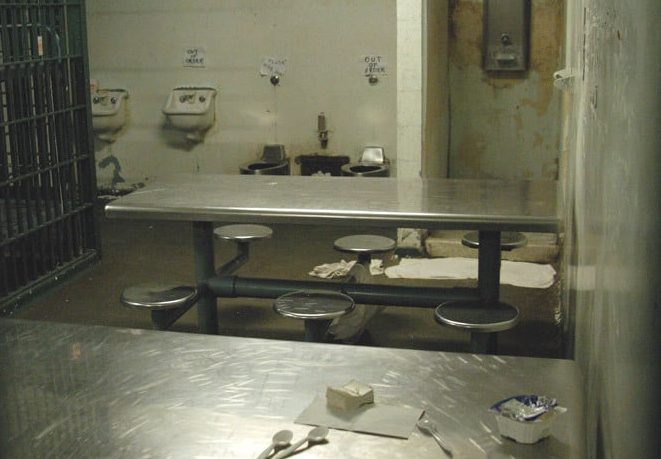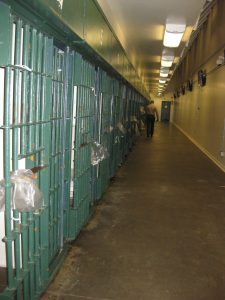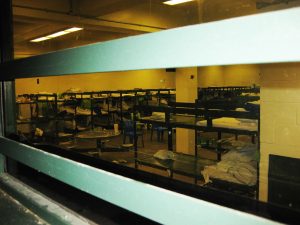At noon on Monday, March 16, Los Angeles County Sheriff Alex Villanueva held a press conference —which was also online — to update everyone on issues related to the COVID-19 crisis, its effect on policing and, most critically, its impact on the vulnerable populations inside the county’s jails, which includes those whose job it is work in the jails.
The sheriff’s manner was very calm and reassuring.
He talked about all the ways he and the department were working hard to make sure that law enforcement services in the areas the LASD serves would be uninterrupted by the coronavirus, and what kind of personal protective equipment to all field personnel were being issued including, masks, gloves, goggles, and more.
He explained that staff vacations had been canceled through the end of April, and those working “non-essential assignments” would be temporarily moved to custody or patrol assignments when necessary to make sure those most crucial areas were adequately staffed.
But it was when Sheriff Villanueva began to talk about the steps he had just taken to lower the population in the county’s enormous jail system that things got really interesting.
“As of Feb. 28, the total population was 17,076,” the sheriff said.
Yet, as of today, he told reporters who ventured out for the press conference (plus everyone who was listening online) the population had dropped to 16,459 — which was a difference of 617 people. And this was a total that Villanueva expected to drop still farther.
The art of dropping the jail pop
The sheriff outlined three big changes that had allowed him to decrease the jail population so rapidly in a little over two weeks.
First, Villanueva said, he ordered the release of anyone who had less than 30 days left on their sentence.
Second, he said, the LASD plus the other law enforcement agencies throughout the county were reducing their number of arrests during the COVID-19 crisis, so fewer people entered the jails in the first place.
The average arrest rate across the county, Villanueva said, is normally around 300 arrests per day. But, in the last week, that number has come down to “about 60 arrests per day,” he said.
The precipitous drop had occurred because LA County Sheriff deputies, along with the LAPD and various other city police forces within the county, were “doing a good job of triaging who it’s necessary to arrest,” and who didn’t need to be cited, Villanueva said.
The third big change the sheriff was making that aided in the drop of the jails’ population had to do with bail.
Prior to COVID-19, he said, the “aggregate bail amount for booking inmates into custody was $25,000,” meaning if your bail was set at $25,000 or higher, you would wind up in county jail — unless you came up with the money or paid a bail bondsman a non-refundable ten percent of your bail amount to pay the cash for you.
Yet, Villanueva found he had the authority to raise that ceiling to $50,000, which allowed more people who were arrested to just receive citations, rather than getting booked into custody. He decreed the new bail standard would apply, “even when there are warrants.”
Cite and release
In general, Sheriff Villanueva said he has directed all local agencies to “cite and release” whenever possible, meaning those people who were cited had to show up at court, but did not have to languish in jail in the meantime.
“This reduces the number of people entering our jail facilities,” said Villanueva, which would, therefore, lower “the chances of the virus being introduced into that environment.”
Villanueva found that he could make these changes under his own authority via California’s Penal Code. (He didn’t mention which part of the code, but likely it is this one.)
Sheriff Villanueva also appeared to feel quite comfortable that he could use these various tactics that were successfully reducing the jail population without harming public safety.
Of course, Villanueva’s strategies also cannot help but raise a question: if arrests can be reduced from 300 to 60 in the space of a week, and the jail population can be dropped by more than 600 people in two weeks, with those numbers evidently expected to keep dropping as these various successful strategies are continued, why can’t LA County similarly reduce arrests and life-upending and unnecessary stints in jail even when we’re not faced with a worldwide pandemic?
Alternatives to Incarceration
As readers might remember, it was one short week ago that, with a motion authored by Supervisors Sheila Kuehl and Mark Ridley-Thomas, the LA County Board of Supervisors voted unanimously to accept a 98-page report from the 25-person Alternatives to Incarceration workgroup (ATI).
This ATI group was made up of members of several county agencies — including two from the LASD –plus justice advocates, and members of LA County’s various communities. It was led by Dr. Robert Ross (who in his day job is the head of the California Endowment), and the group had been working since early last year to create a roadmap for a new countywide system designed to provide “care and services first,” and to use jail as the last resort.
Serendipitously, the sheriff’s COVID-19 strategies appear to be a tangible and very welcome step toward the rebalancing that the ATI report points toward.
His strategies also overlapped with a recent letter from justice advocates, and another letter from the ACLU, both of which were delivered in the last few days to Sheriff Villanueva, the board supervisors, and other county officials, describing changes that need to be instituted in the jails and the courts because of the virus.
On March 12, Peter Eliasberg, Chief Counsel of the ACLU of Southern California, and Jacob Reisberg, its Jails Conditions Advocate, wrote the sheriff about policies for the jails having to do with the crisis that include the early release that the sheriff is now practicing, plus the “cite and release” strategy — along with various safety and cleanliness suggestions pertaining to the jails.
Then on March 13, more than 40 organizations — including Dignity and Power Now, Human Rights Watch, the Youth Justice Coalition, the Antirecidivism Coalition, Homies Unidos, Public Counsel, and around 38 more — sent their letter to the board and the sheriff. They also sent the letter to Los Angeles District Attorney, Jackie Lacey, head of the LA County Department of Health Services, Jackie Clark, plus the two main judges of the LA Superior Court, Hon. Kevin C. Brazile, and Hon. Sam Oht.
Each addressee got his or her own list of strong suggestions from the advocates.
(You can read the full letter here: LA Jails COVID-19 – Advocacy Group Letter 3.13.2020)
When it came to the sheriff, judging by Monday’s press conference, he was already well on the road when it came to putting several of their recommendations into operation.
One suggestion by the justice advocates to Sheriff Villanueva, in particular, seemed missing from his existing strategies to lower the jails population during this period at least, is the request to “suspend arrests and/or booking of individuals suspected of technical parole or probation violation,” which are “behaviors that would not warrant incarceration for people not on parole or probation.”
But we have a long strange road ahead of us when it comes to our new and frightening virus, so there’s still time to add promising strategies.
Large Petri dishes
Unfortunately, lowering the jail population only solves so much.
Most of the county’s facilities are reportedly still huge Petri dishes due to the large numbers of people—staff and incarcerated individuals—who are crowded in small, confined spaces with poor ventilation and too often less than perfect hygiene and cleanliness.
As WitnessLA reported recently, after four-and-a-half-years under a Department of Justice oversight, the basic needs of the jails system’s mentally ill are still not being met, a tragic fact that continues to demonstrate itself in devasting ways (as an upcoming story will report yet again).
According to Supervisor Mark Ridley-Thomas, when members of the Sybil Brand Commission went recently to Central Regional Detention Center, which is the county’s large women’s jail located in Lynwood, CA, they noted a lack of staff preparedness around COVID-19, “as well as poor hygiene and substandard living conditions,” Ridley Thomas said in a statement.
And as the advocates pointed out in their March 13 letter, in L.A. County, we have an aging jail population that the Sheriff’s Department has described as “unwell.”
Then, of course, there are all the kids who are in the LA County Probation’s juvenile halls and youth camps. As with the jails, all visits to the youth facilities are suspended because of the virus, although kids are reportedly supposed to get extra phone time with their families.
In the notification sent out last Friday, March 13, we learned that probation’s Management Services Bureau “is instructing janitorial services at facilities to ensure all bathrooms and staff quarters (where applicable) are cleaned daily and have readily available hand soap, paper towels, toilet paper, hand sanitizers, and disinfectant.”
As with the jails, it would seem that such daily cleanings and the availability of soap, paper towels, and the rest should be standard procedure without a pandemic. (More on these issues later.)
And, as the sheriff has begun to do with the jails, this might be a good time to look hard at whether all the kids in the various halls and camps really need to be there.
PostScript
As we were working on this story, other groups continued to weigh in.
Early on Tuesday morning, 31 elected prosecutors representing over 17 million people across the country issued their own joint statement on the topic of the pandemic and lock-ups, recommending a list of actions to mitigate the spread of COVID-19 among the 2.3 million adults and children held in prisons, local jails, youth correctional facilities, immigration detention centers, and other forms of confinement.
Their recommendations include:
- Adopting cite and release policies for any offense that poses no physical threat to the community.
- Releasing individuals who are being held because they cannot afford cash bail, unless they pose a serious risk to public safety.
- Identifying and releasing the elderly, those with medical conditions that make them more vulnerable to infection, and people within six months of completing their sentence or incarcerated on technical violations of probation and parole – unless doing so would pose a serious public safety risk.
- Implementing humane conditions of confinement – including good medical care and maintaining access to and connections with counsel as well as family and loved ones.
- Dramatically reducing immigration detention and not conducting immigration enforcement operations in and around hospitals or medical clinics.
A few hours later, more than 40 current and former probation and parole executives from across the country, as well as The National Association of Probation Executives, sent us their statement.
It provided suggestions regarding how to limit the impact of coronavirus through correctional population reduction measures.
The recommendations prominently include suspending or severely limiting technical violations for the duration of the coronavirus crisis, along with “reducing intake onto probation and parole” to only those who absolutely need to be under supervision.”
As with the sheriff’s strategies, the prosecutors’ and probation execs’ ideas would also seem to apply to life beyond the COVID-19 world we presently inhabit.
Miriam Krinsky, executive director of Fair and Just Prosecution, which organized the prosecutors’ new statement, agreed.
“We must act now to reduce the existing detained populations and incarcerate fewer people moving forward,” she said. “In doing so, we can not only help to reduce the spread of infection but also bring home people who no longer present a safety risk to their communities.”





Hey Celeste,
Here’s a thought… how about an article entitled “Here is what the COVID-19 Emergency can teach L.A.County about the dangers of a medically untreated homeless population and open borders.”
Yeah, you could then tell about how dangerous it is to have people defecating and urinating in the streets and gutters. The concerns of used syringes laying about and trash that it is rotting/smelling while rats and other vermin feed on it. The lack of anything close to personal hygiene and care by so many.
You could expound on the dangers of people coming across our borders, without being checked, from far away countries (like China and Iran) that have the virus exploding and people who may come here to escape the horror of what’s happening in their own lands only to be possible hosts of the virus and perpetuate it here.
You could investigate and inform us about the millions of dollars sitting unused by our politicians and social services because they funded programs without any planning on how best to implement them and actually help people other than themselves.
Oh, wait….this is all a view that doesn’t fit your narrative/mantras that we always read.
I know, I could not read your “articles” but then I probably wouldn’t be able to better appreciate my believed measured and responsible views on such matters.
When the alternatives to incarceration become addressing how to otherwise stop criminals from doing what they do, your side will have some credibility. Until then, it just smacks of siding with criminals and facilitating their victimization without repercussions.
The lack of balanced reporting and far left, biased articles on this site leads reasonable, thinking pragmatic people to categorize this site, and those like it, as leftist propaganda. It’s like reading the modern version of the Russian Communist Party brainwashing paper “Pravda”. No one grounded in reality takes it serious.
The lack of leadership in this state, mis-guided will, disregard for public health, unwillingness to address homelessness, unchecked immigration and avoidance of reality has put all of us in a dangerous and vulnerable position. The US Senators, Representatives, Governor, legislator, other so called political leaders in the state and large cities such as LA and San Francisco and their media fanboys are culpable and will have their hands soiled when it’s all said and done.
“Of course, Villanueva’s strategies also cannot help but raise a question: …why can’t LA County similarly reduce arrests and life-upending and unnecessary stints in jail even when we’re not faced with a worldwide pandemic?”
“Life-upending and unnecessary stints in jail?” As though these people were just walking down the street and BAM….the POLICE “up-ended” them into jail! And of course, we “up-end” mainly blacks and Latinos because cops are racists (NOT because they commit crimes more often).
Celeste, I’d REALLY like to know what crimes you think are worthy of punishment….NOT “treatment”….NOT “diversion”…..but isolation from society in a locked cell. Breaking into someone house? Car theft? ANY drug crimes (I KNOW that answer)? White collar crimes? Hacking a hospital’s computers during a pandemic? Should we just ELIMINATE all non-violent criminal codes?
What about violent crimes? Does this “vulnerable” population (I mean the criminals, NOT the victims) just need treatment? Are there ANY violent crimes you think merit jail? Slugging a stranger walking down the street? Stabbing someone? Raping a child? Torturing a child? Murder? Would Hitler be spared the death penalty if there was an effective community-based, trauma-informed, treatment facility available? Is EVERYONE redeemable in your view?
Celeste, like many of my liberal friends, I know you’re a good person, so I can’t call you evil, but you’re SO bamboozled by the cult of liberalism, that you’ve lost touch with reality.
[…] when the disaster abates and we have now caught our collective breath, we are able to ask ourselves why we lock up so many suspects, defendants and convicts within the first place, and whether or not they all have to be behind bars for us to be […]
I guess everyone is titled to their opinion even if it goes against all common sense, safeguards and best practices that as human civilization evolved, were put in place to keep society in order.
Again, let us just forgot about the pain, hurt, trauma and suffereing the victims of crime endure (including the elderly, children, babies, etc.) and potential dangers these “justice involved” that pray on others represent to society. By this reasoning, the killers of young Gabriel Fernandez should be released and aren’t bad people? I’m sure if Gascon was the DA at the time of the trials the killers would not have gotten any time but instead just a slap on the hand and warning not to do it again.
All I can say is there are some sick misguided people in this world and all don’t use a gun or knife as their weapon of choice to commit crimes against society.
“Not to all law enforcement, don’t enforce any Public Health Laws or Orders, there’s better alternatives to prevent Pandemic and keep disease carriers from infecting other people.”
Is this what far left thinking individuals and ACLU lawyers want? The destruction of our society will be the end result.
So, is the assumption that the released inmates will go home, self quarantine, cease their anti-social behavior and avail themselves of competent medical care if necessary? Or is it more likely that these people with substance abuse problems, impulse control issues and/or mental illness will re-engage in their unhealthful, self and societal destructive patterns? Maybe the safest place for them is in a custodial environment where their basic nutrition needs are met, medical support is available and, as the Sheriff himself stated, their movement is restricted by jail officials. The “experts” quoted in this article (and others) are social justice advocates, lawyers, opinion reporters and politicians. Suspiciously missing from their statements/suggestions is a supporting opinion of a legitimate public health official from the government. Is there a definitive statement from the CDC or LA County Public Health that releasing inmates is a net benefit to the public during a pandemic? Or does the societal cost of such action outweigh any benefit? If there isn’t such an opinion offered by government health officials shouldn’t some intrepid reporter ask the question? I think the public has a right to the expert opinion and the reasoning behind it.
Celeste we designed a program at LASD in the 1990’s called Release Level Matrix which scored inmates for potential release based on risk scientifically. They have now automated versions of it. I doubt this Sheriff has a clue about it and his plan is dangerous for the poorest of our cities combined with his announcement of non arrests we are asking for problems.
AMEN……Well articulated!
Hoping Celeste Freeman can Contact Celeste Adelle as I have some important questions on another topic that’s private on one of your posts . You might be the only one that could give me some answers that could save me right now . If you could please email me .
I promise I will respond . Thank you